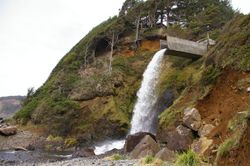Oceanside to Netarts Hike
From Oregon Hikers Field Guide
- Start point: Oceanside Beach Trailhead
- End point: O'Hara Creek
- Trail Log:
- Hike Type: Out and Back
- Distance: 6.0 miles round trip
- High point: 20 feet
- Elevation gain: 20 feet
- Difficulty: Easy
- Seasons: All
- Family Friendly: Yes
- Backpackable: No
- Crowded: Yes, at Oceanside
Contents |
Hike Description
Once upon a time, there was a slick, dangerous, steep path down to this secluded beach between Cape Meares and Maxwell Point. Then a local altruist, Roy Wilson, took it into his head to spend countless hours creating a staircase down to Short Beach. Over the years, various coastal decorations were added by Roy and others who visited. Unfortunately, the trail became a little better known and has been vandalized on occasion. A website has been set up to help with maintaining this quirky, whimsical path. As an aside, visitors should note, the beach was probably named for a long-gone local resident and not for its length.
From the parking area, head down to the beach. Cape Lookout juts out to the south and Maxwell Point is just to your north. Three Arch Rocks (Shag Rock, Finley or Mid Rock, Storm Rock) are just offshore. With binoculars, you may be able to see Steller’s sea lions loafing on Shag Rock. Walk north on the beach first. Approach the tunnel through Maxwell Point that was constructed in 1926. Heed the warning sign about rocks coming down from above. The tunnel itself has standing water although a few planks have been laid. Come out on the cobbled strand of Tunnel Beach, also called Isolation Beach, with its little sea stacks protruding from the ocean on the far side. After wobbling across the little beach, climb up the closest rock to the beach and get a view of Cape Meares to the north and the point which leads to the next beach (Agate Beach), reachable only at a minus tide. The rock is studded with fossil barnacles that are forming little crystal zeolites in their centers. Beyond Agate Beach is the almost inaccessible Lost Boy Cave Beach.
Back on Oceanside Beach, there may be surfers going into the water. The wide beach leads south below the little community, the Three Capes Road leading up over the next bluff. Cross Baughman Creek, which has a sign warning about sewage treatment effluent, and then walk below a development of largish homes on the bluff above. Then to the left, there’s a shore-pine forested dune with a wooden staircase leading down it. The stairs are closed - No Entry Sensitive Ecologocial Area. soon after this, you're passing mudstone cliffs and have to cross wide Fall Creek higher up on logs laid across it. The end of Netarts Spit hoves into view and you round a point heading into Netarts Bay, first passing the cottages of Happy Camp nestled above its driftwood strewn beach. Cross Hodgdon Creek where the strand is narrower and not easily walkable at a high tide. Round the bay and head up a narrow beach below a low riprap wall to a breakwater that shelters a little harbor. Stroll onward to a picnic table above the boat ramp and dock where O’Hara Creek leads into the bay and watch crab boats scoot in loaded with traps and catch. Look for harbor seals bobbing in the placid waters, and then return the way you came.
Maps
- Maps: Hike Finder
Regulations or Restrictions, etc.
- Keep to the trail and the beach; respect private property
- Don't climb the sea stack; it is part of a wildlife refuge
Trip Reports
- Search Trip Reports for Oceanside to Netarts Hike
Related Discussions / Q&A
- Search Trail Q&A for Oceanside to Netarts Hike
Guidebooks that cover this hike
- Oregon's Best Coastal Beaches by Dick Trout
More Links
- The Short Beach Trail Project
- Long on Charm: Tillamook County's Short Beach (Oregon Coast Today)
- "Seeking out secret beaches at Oceanside" (OregonLive)
- Oregon Coast Virtual Tour: Short Beach Near Oceanside, Three Capes Tour (BeachConnection.net)
- Short Beach (Oregon) (Wikipedia)
Contributors
- bobcat (creator)






